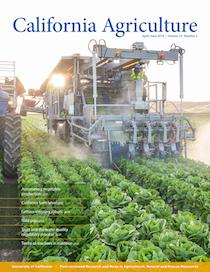
Automated Lettuce Thinners Reduce Labor Requirements and Increase Speed of Thinning
by Elizabeth Mosqueda,
Salinas Valley lettuce growers are adopting automated lettuce thinners to improve labor efficiency. We conducted field studies in 2014 and 2015 to compare the time involved in automated and manual thinning of direct-seeded lettuce and any differences in lettuce quality and yield. We recorded the number of doubles (two closely spaced plants) left behind after thinning, time taken to remove the doubles, final crop stand, efficiency in weed removal, crop yield and disease incidence. Using an automated thinner in place of manual hoeing reduced the thinning labor requirement from 7.31 ± 0.5 person-hours per acre to 2.03 ± 0.5 person-hours per acre. Automated thinning left more doubles than manual thinning, resulting in additional time to remove them, but was overall more labor-efficient and had no impact on yield or disease incidence.
Next-generation mechanization
by Jim Downing,